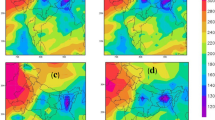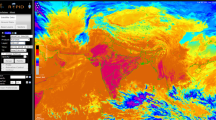Abstract
Satellites basically measure the radiance coming from the earth’s surface and cloud tops. By making such measurements at appropriate wavelengths and applying physical and statistical techniques, it is possible to compute a wide range of products for weather monitoring and forecasting. Further, the satellite meteorological data on a global scale are vital inputs in Numerical Weather Prediction (NWP) models as initial conditions. For a tropical country like India where high-impact convective events are very common, it is necessary to have good quality high density observations both in spatial and temporal scale to ingest into an assimilation cycle of NWP models. In view of the importance of satellite data, accurate estimation of satellite observations could be the only viable alternative solution for data sparse regions. Availability of multi-spectral imager channels in INSAT3D/3DR satellites with the staggering mode of temporal frequency at every 15 min provides us a new way to look at the weather events over the Indian region. The most effective ways to utilize these products are by combining the channels using red–green–blue (RGB) composites of INSAT3D/3DR satellite with its microphysical properties and RAPID SCAN mode. The RAPID scan mode has a higher temporal resolution, i.e., approximately 4 min unlike 30-min of conventional mode, for analyzing weather phenomena particularly intensification, propagation, and decay of various types of weather systems including nowcasting applications. Further, INSAT3D/3DR sounder provides continuous upper level temperature and moisture profiles with a spatial resolution of 10 × 10 km with temporal resolution of half an hour. With its sounder payload, the amount of the water vapor present in the atmospheric column in the form of total precipitable water (TPW) is being retrieved operationally and can be considered as a precursor for mesoscale activities.
Access this chapter
Tax calculation will be finalised at checkout
Purchases are for personal use only
Similar content being viewed by others
References
Bader MJ, Forbes GS, Grant JR, Lilly RBE, Waters J (1995) Images in weather forecasting. Cambridge University Press, 493 pp
Ellord GP (1995) Advances in the detection and analysis of fog at night using GOES multi spectral infrared imagery. Weather Forecast 10:606–619
Eyre JR, Brownscombe JL, Allam RJ (1984) Detection of fog at night using advanced very high resolution radiometer. Meteorol Mag 113:266–271
Hubert LF, Lehr PE (1967) Weather satellites. Published: Blaisdell Publication Company
Inoue T (1987) An instantaneous delineation of convective rainfall areas using split window data of NOAA-7 AVHRR. J Meteor Soc Japan 65:469–481
Lensky IM, Rosenfeld D (2003a) Satellite-based insights into precipitation formation processes in continental and maritime convective clouds at nighttime. J Appl Meteor 42:1227–1233
Lensky IM, Rosenfeld D (2003b) A night rain delineation algorithm for infrared satellite data based on microphysical considerations. J Appl Meteor 42:1218–1226
Lensky IM, Rosenfeld D (2008) Clouds-aerosols-precipitation satellite analysis tool (CAPSAT). Atmos Chem Phys 8:6739–6753
Li Z, Li J, Menzel WP, Timothy JS, James PN, Daniels J, Ackerman SA (2008) GOES sounding improvement and applications to severe storm now casting. Geophys Res Lett 35:3
Ma XL, Schmit TJ, Smith WL (1999) A nonlinear physical retrieval algorithm—its application to the GOES-8/9 sounder. J Appl Meteorol 38:501–513
Mitra A, Bhan S, Sharma A, Kaushik N, Parihar S, Mahandru R, Kundu PK (2015) INSAT-3D vertical profile retrievals at IMDPS, New Delhi. Mausam 66:687–694
Mitra AK, Shailesh P, Bhatla R, Ramesh KJ (2018) Identification of weather events from INSAT-3D RGB scheme using RAPID tool. Curr Sci 115(7), 10 October 2018
Parihar S, Mitra AK, Mohapatra M, Bhatla R (2018) Potential of INSAT-3D sounder-derived total precipitable water product for weather forecast. Atmos Measure Tech 11:6003–6012. https://doi.org/10.5194/amt-11-6003-2018
Setvak M, Lindsey DT, Novak P, Wang PK, Radová M, Kerkmann J, Grasso L, Su S-H, Rabin RM, Štʼástka J, Charvát Z (2010) Satellite-observed cold-ring-shaped features atop deep convective clouds. Atmos Res 97:80–96. https://doi.org/10.1016/j.atmosres.2010.03.009
Schmit TJ, Goodman SJ, Lindsey DT. Rabin RM, Bedka KM, Gunshor MM, Cintineo JL, Velden CS, Scott Bachmeier A, Lindstrom SS, Schmidt CC (2013) Geostationary operational environmental satellite (GOES)-14 super rapid scan operations to prepare for GOES-R. J Appl Remote Sens 7:073462
Trenberth KE, Olson JG (1988) An evaluation and intercomparison of global analyses from the National Meteorological Center and the European centre for medium range weather forecasts. AMS 28:477–1520
Yuan L, Anthes R, Ware R, Rocken C, Bonner W, Bevis M, Businger S (1993) Sensing climate change using the global positioning systems. J Geophys Res 98:25–30
Acknowledgements
I am grateful to Dr. M. Mohapatra, Director General of Meteorology IMD for his valuable suggestions and providing all facilities to complete the work. I am also very much grateful to SAC, Ahmadabad team for their technical, software expertise and implementation of “RAPID” tool at IMDPS, New Delhi. Finally, I am thankful to Dr. M. Rajeevan, Secretary, MoES for his great support and encouragement.
Author information
Authors and Affiliations
Corresponding author
Editor information
Editors and Affiliations
Rights and permissions
Copyright information
© 2023 Indian National Science Academy
About this chapter
Cite this chapter
Mitra, A.K. (2023). Use of Remote Sensing in Weather and Climate Forecasts. In: Gahalaut, V.K., Rajeevan, M. (eds) Social and Economic Impact of Earth Sciences. Springer, Singapore. https://doi.org/10.1007/978-981-19-6929-4_5
Download citation
DOI: https://doi.org/10.1007/978-981-19-6929-4_5
Published:
Publisher Name: Springer, Singapore
Print ISBN: 978-981-19-6928-7
Online ISBN: 978-981-19-6929-4
eBook Packages: Earth and Environmental ScienceEarth and Environmental Science (R0)




